2I)6LRBQ+bwGm!Lw~~60_12.JPG) the settlement of Deadwood began in the 1870s and has been described as illegal, since it lay within the territory granted toNative Americans in the 1868 Treaty of Laramie.
the settlement of Deadwood began in the 1870s and has been described as illegal, since it lay within the territory granted toNative Americans in the 1868 Treaty of Laramie.  treaty had guaranteed ownership of the Black Hills to the Lakota people,
treaty had guaranteed ownership of the Black Hills to the Lakota people, and disputes over the Hills are ongoing, having reached the United States Supreme Court on several occasions.
and disputes over the Hills are ongoing, having reached the United States Supreme Court on several occasions. 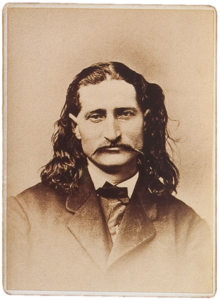 hickock
hickock
However, in 1874, Colonel George Armstrong Custer led an expedition into the Hills  announced the discovery of gold on French Creek
announced the discovery of gold on French Creek  near present-day Custer, South Dakota.
near present-day Custer, South Dakota. Custer's announcement triggered the Black Hills Gold Rush
Custer's announcement triggered the Black Hills Gold Rush  gave rise to the lawless town of Deadwood, which quickly reached a population of around 5,000.
gave rise to the lawless town of Deadwood, which quickly reached a population of around 5,000.
 announced the discovery of gold on French Creek
announced the discovery of gold on French Creek  near present-day Custer, South Dakota.
near present-day Custer, South Dakota. Custer's announcement triggered the Black Hills Gold Rush
Custer's announcement triggered the Black Hills Gold Rush  gave rise to the lawless town of Deadwood, which quickly reached a population of around 5,000.
gave rise to the lawless town of Deadwood, which quickly reached a population of around 5,000.
In early 1876, frontiersman Charlie Utter and his brother Steve led a wagon train to Deadwood containing what were deemed to be needed commodities to bolster business. The wagon train brought gamblers and prostitutes, resulting in the establishment of profitable ventures. Demand for women was high,
Demand for women was high, and the business of prostitution proved to have a good market.
and the business of prostitution proved to have a good market.uLKVH,BRBDV(2o4Q~~60_12.JPG) MadamDora DuFran would eventually
MadamDora DuFran would eventually become the most profitable brothel owner in Deadwood, closely followed by
become the most profitable brothel owner in Deadwood, closely followed by Madam Mollie Johnson. Businessman Tom Miller opened the Bella Union Saloon
Madam Mollie Johnson. Businessman Tom Miller opened the Bella Union Saloon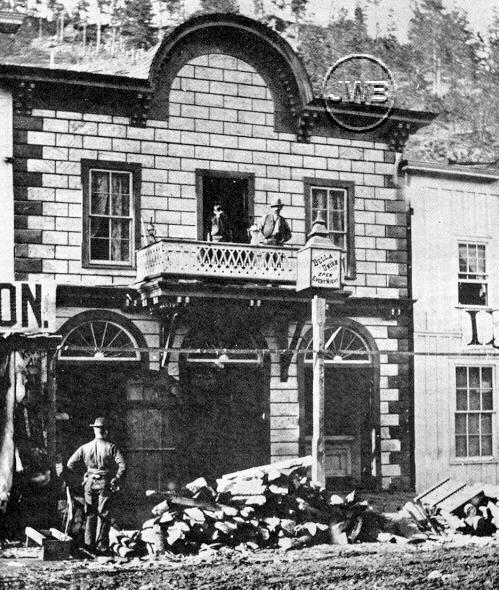 in September of that year.
in September of that year.
 Demand for women was high,
Demand for women was high, and the business of prostitution proved to have a good market.
and the business of prostitution proved to have a good market.uLKVH,BRBDV(2o4Q~~60_12.JPG) MadamDora DuFran would eventually
MadamDora DuFran would eventually become the most profitable brothel owner in Deadwood, closely followed by
become the most profitable brothel owner in Deadwood, closely followed by Madam Mollie Johnson. Businessman Tom Miller opened the Bella Union Saloon
Madam Mollie Johnson. Businessman Tom Miller opened the Bella Union Saloon in September of that year.
in September of that year.
The town attained notoriety for the murder of Wild Bill Hickok, and Mount Moriah Cemetery remains the final resting place of Hickok and Calamity Jane, as well as slightly less notable figures such as Seth Bullock.
zg~~60_12.JPG) Deadwood became known for its wild and almost lawless reputation, during which time murder was common, and punishment for murders not always fair and impartial. Hickok's murderer, Jack McCall, was prosecuted twice, despite the U.S. Constitution's prohibition against double jeopardy,
Deadwood became known for its wild and almost lawless reputation, during which time murder was common, and punishment for murders not always fair and impartial. Hickok's murderer, Jack McCall, was prosecuted twice, despite the U.S. Constitution's prohibition against double jeopardy,  because of a ruling that Deadwood was an illegal town in Indian Territory and thus lacked the jurisdiction to prosecute or acquit McCall. This decision moved McCall's trial to a Dakota Territory court ("Indian Court"), where he was found guilty of murder and hanged.
because of a ruling that Deadwood was an illegal town in Indian Territory and thus lacked the jurisdiction to prosecute or acquit McCall. This decision moved McCall's trial to a Dakota Territory court ("Indian Court"), where he was found guilty of murder and hanged.
Another saloon was the Gem Variety Theater , opened April 7, 1877 by Al Swearengen who also controlled the opium trade in the town. The saloon was
, opened April 7, 1877 by Al Swearengen who also controlled the opium trade in the town. The saloon was  destroyed by a fire and rebuilt in 1879. It burned down again in 1899, causing Swearengen to leave the town.
destroyed by a fire and rebuilt in 1879. It burned down again in 1899, causing Swearengen to leave the town.
 , opened April 7, 1877 by Al Swearengen who also controlled the opium trade in the town. The saloon was
, opened April 7, 1877 by Al Swearengen who also controlled the opium trade in the town. The saloon was  destroyed by a fire and rebuilt in 1879. It burned down again in 1899, causing Swearengen to leave the town.
destroyed by a fire and rebuilt in 1879. It burned down again in 1899, causing Swearengen to leave the town.
As the economy changed from gold rush to steady mining, Deadwood lost its rough and rowdy character and settled down into a prosperous town. In 1876, a smallpox epidemic swept through the camp with so many falling nBQ8C2FiQbw~~60_12.JPG) ill that tents were erected to quarantine the stricken. On December 13, 1959, the ABC/Warner Brothers western television series Colt .45 aired the episode "Calamaity", a dramatization of the event. Dody Heath was cast as Calamity Jane and Joan Taylor as a woman doctor,
ill that tents were erected to quarantine the stricken. On December 13, 1959, the ABC/Warner Brothers western television series Colt .45 aired the episode "Calamaity", a dramatization of the event. Dody Heath was cast as Calamity Jane and Joan Taylor as a woman doctor, Ellen McGraw. In the story line, series character Christopher Colt, played by Wayde Preston
Ellen McGraw. In the story line, series character Christopher Colt, played by Wayde Preston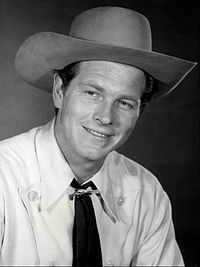 , hires Calamity Jane to drive the stagecoach containing Dr. McGraw and the vaccine needed to fight the epidemic. Colt is at first unsure if Calamity can handle the job because miners and Indians seek to steal the valuable medication.
, hires Calamity Jane to drive the stagecoach containing Dr. McGraw and the vaccine needed to fight the epidemic. Colt is at first unsure if Calamity can handle the job because miners and Indians seek to steal the valuable medication.
nBQ8C2FiQbw~~60_12.JPG) ill that tents were erected to quarantine the stricken. On December 13, 1959, the ABC/Warner Brothers western television series Colt .45 aired the episode "Calamaity", a dramatization of the event. Dody Heath was cast as Calamity Jane and Joan Taylor as a woman doctor,
ill that tents were erected to quarantine the stricken. On December 13, 1959, the ABC/Warner Brothers western television series Colt .45 aired the episode "Calamaity", a dramatization of the event. Dody Heath was cast as Calamity Jane and Joan Taylor as a woman doctor, Ellen McGraw. In the story line, series character Christopher Colt, played by Wayde Preston
Ellen McGraw. In the story line, series character Christopher Colt, played by Wayde Preston , hires Calamity Jane to drive the stagecoach containing Dr. McGraw and the vaccine needed to fight the epidemic. Colt is at first unsure if Calamity can handle the job because miners and Indians seek to steal the valuable medication.
, hires Calamity Jane to drive the stagecoach containing Dr. McGraw and the vaccine needed to fight the epidemic. Colt is at first unsure if Calamity can handle the job because miners and Indians seek to steal the valuable medication.
In 1876, General George Crook pursued the Sioux Indians from the Battle of Little Big Horn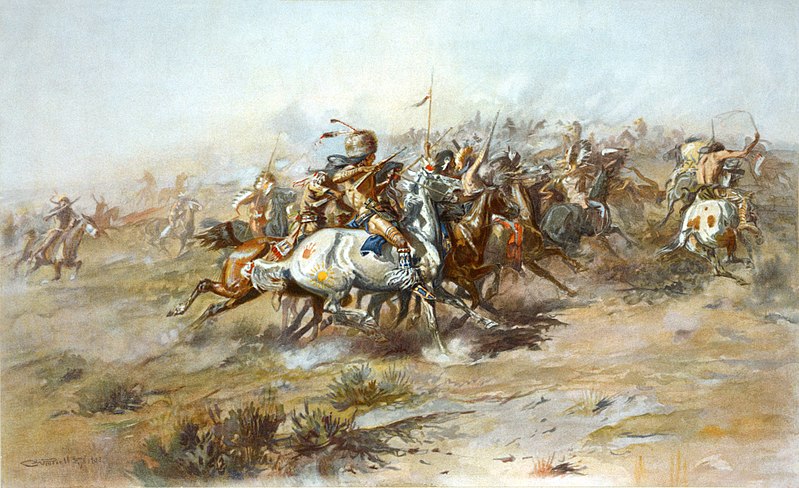 on an expedition that ended in Deadwood and is known as the Horsemeat March. The Horsemeat March of 1876, also known as the Starvation March, was a military expedition led by General George Crook in pursuit of a band of Sioux fleeing General Custer's
on an expedition that ended in Deadwood and is known as the Horsemeat March. The Horsemeat March of 1876, also known as the Starvation March, was a military expedition led by General George Crook in pursuit of a band of Sioux fleeing General Custer's 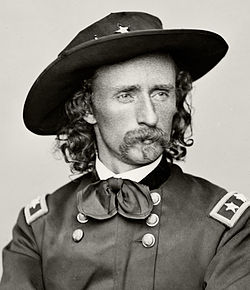 at the Battle of Little Big Horn. In September, after the battle of Slim Buttes, the Sioux burned the grass behind them, and the American cavalry traveled with reduced rations to allow faster pursuit. As a result, the cavalry had no food for men or
at the Battle of Little Big Horn. In September, after the battle of Slim Buttes, the Sioux burned the grass behind them, and the American cavalry traveled with reduced rations to allow faster pursuit. As a result, the cavalry had no food for men or  horses, and the soldiers eventually had to shoot and eat their horses as they became lame or injured. The Horsemeat March ended in Deadwood, South Dakota.
horses, and the soldiers eventually had to shoot and eat their horses as they became lame or injured. The Horsemeat March ended in Deadwood, South Dakota.  Many of the cavalrymen were said to have gone insane as a result of the march. Homestake Mine in nearby Lead
Many of the cavalrymen were said to have gone insane as a result of the march. Homestake Mine in nearby LeadsE9swmcMmrBQ8Cc!j7dw~~60_12.JPG) was established in 1877. For years, it was the longest continuously operating gold mine in the United States. It is now open to tourists.
was established in 1877. For years, it was the longest continuously operating gold mine in the United States. It is now open to tourists.
 on an expedition that ended in Deadwood and is known as the Horsemeat March. The Horsemeat March of 1876, also known as the Starvation March, was a military expedition led by General George Crook in pursuit of a band of Sioux fleeing General Custer's
on an expedition that ended in Deadwood and is known as the Horsemeat March. The Horsemeat March of 1876, also known as the Starvation March, was a military expedition led by General George Crook in pursuit of a band of Sioux fleeing General Custer's  at the Battle of Little Big Horn. In September, after the battle of Slim Buttes, the Sioux burned the grass behind them, and the American cavalry traveled with reduced rations to allow faster pursuit. As a result, the cavalry had no food for men or
at the Battle of Little Big Horn. In September, after the battle of Slim Buttes, the Sioux burned the grass behind them, and the American cavalry traveled with reduced rations to allow faster pursuit. As a result, the cavalry had no food for men or  horses, and the soldiers eventually had to shoot and eat their horses as they became lame or injured. The Horsemeat March ended in Deadwood, South Dakota.
horses, and the soldiers eventually had to shoot and eat their horses as they became lame or injured. The Horsemeat March ended in Deadwood, South Dakota.  Many of the cavalrymen were said to have gone insane as a result of the march. Homestake Mine in nearby Lead
Many of the cavalrymen were said to have gone insane as a result of the march. Homestake Mine in nearby LeadsE9swmcMmrBQ8Cc!j7dw~~60_12.JPG) was established in 1877. For years, it was the longest continuously operating gold mine in the United States. It is now open to tourists.
was established in 1877. For years, it was the longest continuously operating gold mine in the United States. It is now open to tourists.
On September 26, 1879, a fire devastated Deadwood, destroyed more than three hundred buildings, and consumed the belongings of many inhabitants. Many of the newly impoverished left town to start again elsewhere without the opportunities of rich untapped veins of ore that characterized the early days of Deadwood.
A narrow-gauge railroad,  Deadwood Central Railroad, was founded by Deadwood resident J.K.P. Miller and his associates in 1888, in order to serve their mining interests in the Black Hills.
Deadwood Central Railroad, was founded by Deadwood resident J.K.P. Miller and his associates in 1888, in order to serve their mining interests in the Black Hills. The railroad was purchased by the Chicago, Burlington and Quincy Railroad in 1893. A portion of the railroad between Deadwood
The railroad was purchased by the Chicago, Burlington and Quincy Railroad in 1893. A portion of the railroad between Deadwood  Lead was electrified in 1902 for operation as an interurbanpassenger system, which operated until 1924.
Lead was electrified in 1902 for operation as an interurbanpassenger system, which operated until 1924. The railroad was abandoned in 1930, apart from a portion from Kirk to Fantail Junction, which was converted to
The railroad was abandoned in 1930, apart from a portion from Kirk to Fantail Junction, which was converted to  standard gauge. The remaining section was abandoned by the successor Burlington Northern Railroad in 1984.
standard gauge. The remaining section was abandoned by the successor Burlington Northern Railroad in 1984.
 Deadwood Central Railroad, was founded by Deadwood resident J.K.P. Miller and his associates in 1888, in order to serve their mining interests in the Black Hills.
Deadwood Central Railroad, was founded by Deadwood resident J.K.P. Miller and his associates in 1888, in order to serve their mining interests in the Black Hills. The railroad was purchased by the Chicago, Burlington and Quincy Railroad in 1893. A portion of the railroad between Deadwood
The railroad was purchased by the Chicago, Burlington and Quincy Railroad in 1893. A portion of the railroad between Deadwood  Lead was electrified in 1902 for operation as an interurbanpassenger system, which operated until 1924.
Lead was electrified in 1902 for operation as an interurbanpassenger system, which operated until 1924. The railroad was abandoned in 1930, apart from a portion from Kirk to Fantail Junction, which was converted to
The railroad was abandoned in 1930, apart from a portion from Kirk to Fantail Junction, which was converted to  standard gauge. The remaining section was abandoned by the successor Burlington Northern Railroad in 1984.
standard gauge. The remaining section was abandoned by the successor Burlington Northern Railroad in 1984.
Some of the other early town residents and frequent visitors included Al Swearengen, E. B. Farnum, Charlie Utter , Sol Star
, Sol Star , Martha Bullock
, Martha Bullock , A. W. Merrick, Samuel Fields, Calamity Jane
, A. W. Merrick, Samuel Fields, Calamity Jane , Dr. Valentine McGillycuddy
, Dr. Valentine McGillycuddy , the Reverend Henry Weston Smith, and Wild Bill Hickok.
, the Reverend Henry Weston Smith, and Wild Bill Hickok.
 , Sol Star
, Sol Star , Martha Bullock
, Martha Bullock , A. W. Merrick, Samuel Fields, Calamity Jane
, A. W. Merrick, Samuel Fields, Calamity Jane , Dr. Valentine McGillycuddy
, Dr. Valentine McGillycuddy , the Reverend Henry Weston Smith, and Wild Bill Hickok.
, the Reverend Henry Weston Smith, and Wild Bill Hickok.
Another major fire in September 1959 came close to destroying the town. About 4,500 square miles (12,000 km2) were burned and an evacuation order was issued. Nearly 3,600 volunteer and professional firefighters, including personnel from the Homestake Mineand Ellsworth Air Force Base, worked to contain the fire,
including personnel from the Homestake Mineand Ellsworth Air Force Base, worked to contain the fire,  which resulted in a major regional economic downturn.
which resulted in a major regional economic downturn.
 including personnel from the Homestake Mineand Ellsworth Air Force Base, worked to contain the fire,
including personnel from the Homestake Mineand Ellsworth Air Force Base, worked to contain the fire,  which resulted in a major regional economic downturn.
which resulted in a major regional economic downturn.
The entire town was designated a National Historic Landmark in 1961. However, the town underwent additional  decline and financial stresses during the next two decades.Interstate 90 bypassed it in 1964 and its
decline and financial stresses during the next two decades.Interstate 90 bypassed it in 1964 and its  were shut down after a 1980 raid.
were shut down after a 1980 raid.qdBRBD(uwG+w~~60_12.JPG) A fire in December 1987 destroyed the historic Syndicate Building and a neighboring structure.
A fire in December 1987 destroyed the historic Syndicate Building and a neighboring structure. The fire spurred the "Deadwood Experiment", in which gambling was tested as a means of revitalizing a city center.At the time, gambling was legal only in the state of Nevada and in Atlantic City.
The fire spurred the "Deadwood Experiment", in which gambling was tested as a means of revitalizing a city center.At the time, gambling was legal only in the state of Nevada and in Atlantic City.
 decline and financial stresses during the next two decades.Interstate 90 bypassed it in 1964 and its
decline and financial stresses during the next two decades.Interstate 90 bypassed it in 1964 and its  were shut down after a 1980 raid.
were shut down after a 1980 raid.qdBRBD(uwG+w~~60_12.JPG) A fire in December 1987 destroyed the historic Syndicate Building and a neighboring structure.
A fire in December 1987 destroyed the historic Syndicate Building and a neighboring structure. The fire spurred the "Deadwood Experiment", in which gambling was tested as a means of revitalizing a city center.At the time, gambling was legal only in the state of Nevada and in Atlantic City.
The fire spurred the "Deadwood Experiment", in which gambling was tested as a means of revitalizing a city center.At the time, gambling was legal only in the state of Nevada and in Atlantic City.
Deadwood was the first small community in the U.S. to seek legal gambling revenues as a way of maintaining local historic qualities. Gambling was legalized in Deadwood in 1989 and immediately brought significant new revenues and development.The pressure of development may
in 1989 and immediately brought significant new revenues and development.The pressure of development may  have an effect on the historical integrity of the landmark district.
have an effect on the historical integrity of the landmark district.
 in 1989 and immediately brought significant new revenues and development.The pressure of development may
in 1989 and immediately brought significant new revenues and development.The pressure of development may  have an effect on the historical integrity of the landmark district.
have an effect on the historical integrity of the landmark district.
The gold rush attracted Chinese immigrants to the area. Their population peaked at 250. A few engaged in mining; most worked in service enterprises. A quarter arose on Main Street, encouraged by the lack of
A few engaged in mining; most worked in service enterprises. A quarter arose on Main Street, encouraged by the lack of  restrictions on foreign property ownership in Dakota Territory and a relatively high level of tolerance.
restrictions on foreign property ownership in Dakota Territory and a relatively high level of tolerance. Wong Fee Lee arrived in Deadwood in 1876 and became a leading merchant.
Wong Fee Lee arrived in Deadwood in 1876 and became a leading merchant.  was a community leader among the Chinese Americans until his death in 1921.
was a community leader among the Chinese Americans until his death in 1921.
 A few engaged in mining; most worked in service enterprises. A quarter arose on Main Street, encouraged by the lack of
A few engaged in mining; most worked in service enterprises. A quarter arose on Main Street, encouraged by the lack of  restrictions on foreign property ownership in Dakota Territory and a relatively high level of tolerance.
restrictions on foreign property ownership in Dakota Territory and a relatively high level of tolerance. Wong Fee Lee arrived in Deadwood in 1876 and became a leading merchant.
Wong Fee Lee arrived in Deadwood in 1876 and became a leading merchant.  was a community leader among the Chinese Americans until his death in 1921.
was a community leader among the Chinese Americans until his death in 1921.
The quarter's residents also included African-Americans and Americans of European extractionstate sponsored an archeological dig in the area during the 2000s..

In the summer, there are numerous trails for hiking, mountain biking, and horse back riding.  northern end of the George S. Mickelson Trail starts in Deadwood and runs south through the Black Hills to Edgemont. Several man made lakes, including Sheridan Lake,
northern end of the George S. Mickelson Trail starts in Deadwood and runs south through the Black Hills to Edgemont. Several man made lakes, including Sheridan Lake, provide fishing and swimming. Spearfish Canyon
provide fishing and swimming. Spearfish Canyon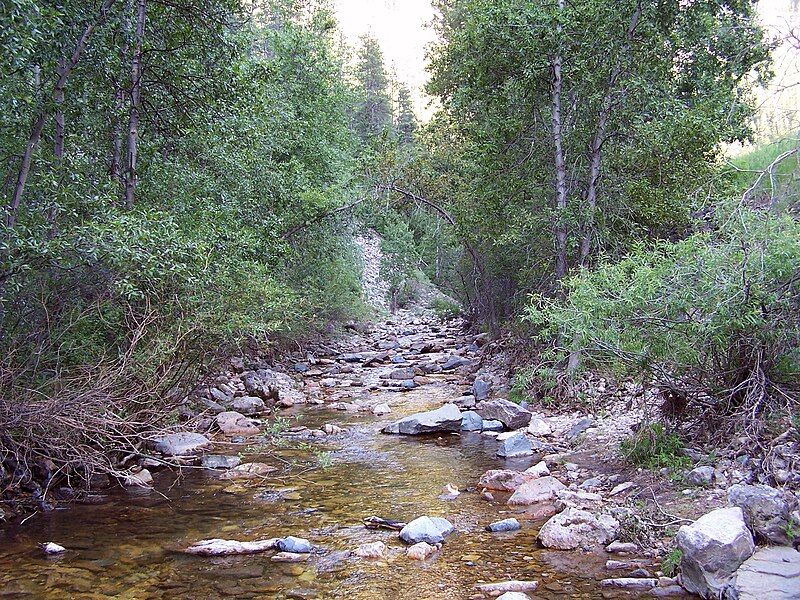 to the north has many places to rock climb. In early June the Mickelson Trail Marathon and 5K, as well as accompanying races for children, are held.
to the north has many places to rock climb. In early June the Mickelson Trail Marathon and 5K, as well as accompanying races for children, are held.
 northern end of the George S. Mickelson Trail starts in Deadwood and runs south through the Black Hills to Edgemont. Several man made lakes, including Sheridan Lake,
northern end of the George S. Mickelson Trail starts in Deadwood and runs south through the Black Hills to Edgemont. Several man made lakes, including Sheridan Lake, provide fishing and swimming. Spearfish Canyon
provide fishing and swimming. Spearfish Canyon to the north has many places to rock climb. In early June the Mickelson Trail Marathon and 5K, as well as accompanying races for children, are held.
to the north has many places to rock climb. In early June the Mickelson Trail Marathon and 5K, as well as accompanying races for children, are held.
During the winter there are two ski areas just a few miles outside of nearby Lead, SD – Terry Peak and Deer Mountain.

"The Midnight Star" casino in Deadwood is owned by American film actor Kevin Costner. International versions of many of his films' posters line its walls.
International versions of many of his films' posters line its walls.nBQ8Dg3hW1w~~60_12.JPG)
 International versions of many of his films' posters line its walls.
International versions of many of his films' posters line its walls.nBQ8Dg3hW1w~~60_12.JPG)
Deadwood's climate varies considerably from the rest of the state and surrounding areas. While most of the state receives less than 15 inches of precipitation per year, annual precipitation amounts in the Lead-Deadwood
receives less than 15 inches of precipitation per year, annual precipitation amounts in the Lead-Deadwood  area reach nearly 30 inches. Most of these 30 inches fall in the winter as snow, although snow can occur as
area reach nearly 30 inches. Most of these 30 inches fall in the winter as snow, although snow can occur as  early as September and last until late May. Spring is brief and is characterized by large wet snow storms and periods of rain
early as September and last until late May. Spring is brief and is characterized by large wet snow storms and periods of rain
 receives less than 15 inches of precipitation per year, annual precipitation amounts in the Lead-Deadwood
receives less than 15 inches of precipitation per year, annual precipitation amounts in the Lead-Deadwood  area reach nearly 30 inches. Most of these 30 inches fall in the winter as snow, although snow can occur as
area reach nearly 30 inches. Most of these 30 inches fall in the winter as snow, although snow can occur as  early as September and last until late May. Spring is brief and is characterized by large wet snow storms and periods of rain
early as September and last until late May. Spring is brief and is characterized by large wet snow storms and periods of rain


